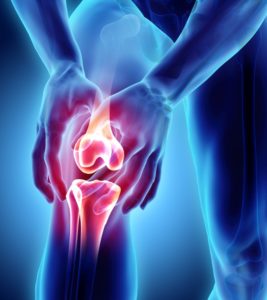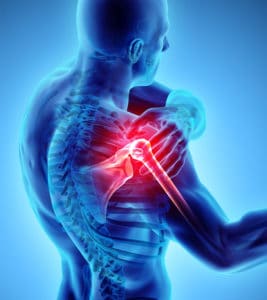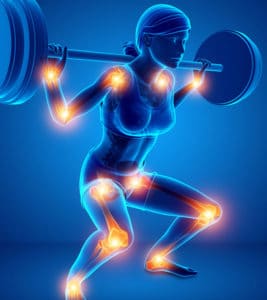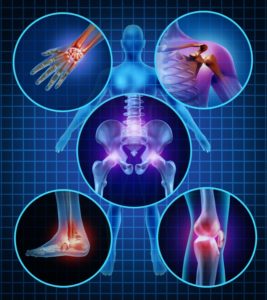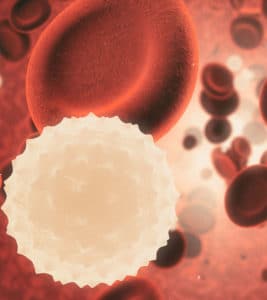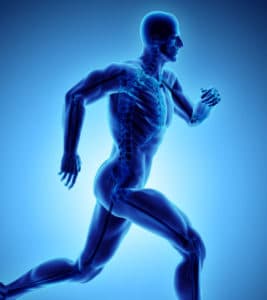Arthritis
Knee Arthritis
Arthritis is a condition that causes pain, stiffness and swelling in the joints. Osteoarthritis is the most common form of arthritis and it commonly affects the knees. Arthritis of the knee may develop as the cartilage protecting the bones of the knee joint wears down over time. Over the years, as stress is put on the joints, cartilage wears thin and sometimes even erodes completely, resulting in stiffness and pain. Arthritis of the knee occurs more frequently in older individuals, however it sometimes develops in athletes from overuse of the knee joint or after an injury.
Symptoms of arthritis of the knee may include pain, swelling and stiffness within the joint. Some individuals also experience a feeling of weakness in the knee that results in the knee locking or buckling. These symptoms tend to worsen after increased physical activity and as the condition progresses. Over time, as arthritis of the knee progresses, the knee joint becomes increasingly stiff and inflamed, difficult to move, and very painful, even when at rest.
To diagnose arthritis of the knee, a doctor will review all symptoms and perform a physical examination. X-rays and other imaging tests are often used to assess the amount of damage to the joint. Treatment for arthritis of the knee initially focuses on relieving pain and addressing symptoms and is commonly treated with a combination of methods. Avoiding certain physical activities that place stress on the knee may be helpful. Medication may also be used to treat pain and may include:
- Anti-inflammatory medication such as aspirin, ibuprofen or acetaminophen
- Prescription pain relievers
- Corticosteroid injections
Physical therapy may be a successful form of treatment for some patients. Severe cases of osteoarthritis of the knee may require surgery to reposition the bones or replace the joint. Most procedures can be performed through arthroscopy, which significantly reduces bleeding, scarring and recovery times.
Steroid Injections For Arthritis
Arthritis is a condition that causes, pain, swelling and stiffness in the joints. Treatment for arthritis may vary, but the main goal is to reduce inflammation and pain. Most patients may try several different treatment options before finding a method that works best for their individual condition. Steroid injections are an advanced treatment option for patients with arthritis and other sources of joint pain, that have not responded well to other treatments such as exercise and oral medications. These injections deliver relief directly to the source of the pain and are considered safe for nearly all patients.
Most steroid injections provide immediate anti-inflammatory relief by being injected directly into the affected joint. These injections are an effective method of treatment to reduce the swelling of tendons and ease pressure on the nerve. A steroid medication such as cortisone, is injected directly into the inflamed area and works by minimizing the body’s reaction to inflammation. As the inflammation decreases, the pressure is relieved, therefore causing pain and discomfort to subside. As a result, patients experience a decrease in symptoms such as pain, swelling, numbness or stiffness. Symptoms may subside within a few days and the results of the injection may last for a few weeks or up to a few months.
Ultrasound-Guided Joint Injections
Joint injections are a minimally invasive treatment for relieving pain caused by inflammatory joint conditions such as rheumatoid arthritis, tendonitis, bursitis and gout. To reduce pain and inflammation from these conditions, medications such as corticosteroids and hyaluronic-acid preparations are sometimes injected into the problem joint. The medications affect only the targeted areas, and usually do not cause side effects. Joint injections are administered under local anesthesia, and cause only brief, mild discomfort.
To ensure precise administration of, and effective results from, joint injections, they are often performed under ultrasound guidance. Ultrasound uses high-frequency sound waves to produce real-time images of the internal structures of the body; no radiation is involved and there are no side effects. As with traditional injections, ultrasound-guided injections are made with standard needles and syringes. The difference is that, during ultrasound, a probe attached to a monitor is placed against the skin in the target area; this gives the physician an internal view of the joint to be injected. The physician watches the monitor as she or he places the needle into the joint, ensuring precise placement.
Joint injections can be used to relieve pain in the following areas:
- Knee
- Shoulder
- Ankle
- Elbow
- Wrist
- Thumb
- Hip
Unless they have joint infections or allergies to the medications used, most people are candidates for ultrasound-guided joint injections, which generally take between 15 and 30 minutes to perform.
Total Knee Arthroplasty
Patients with severe pain and stiffness that does not respond to conservative treatments or more moderate surgery may require total knee arthroplasty, commonly known as knee replacement, to relieve pain and restore function. Whereas in a healthy knee smooth cartilage cushions the connecting bone ends, when osteoarthritis develops, the resulting pain and stiffness that may require surgical intervention.
In a total knee arthroplasty, the damaged ends of the bones are removed and replaced with a prosthesis made of metal and plastic. These artificial parts allow the joint to move smoothly so the patient experiences pain relief and a better quality of life.
Total Knee Arthroplasty Procedure
The total knee replacement procedure is performed in a hospital under general anesthesia. During the procedure, an incision is made in the knee to access the joint so the damaged bone and cartilage can be removed. Once the damaged tissue is removed, the prosthetic device is inserted and may be either cemented or pressed into place. Cemented knee replacements are most commonly used, and are fixed into the joint for immediate support. Press-fit knee replacements are designed to have the surrounding bone grow into the implant for long-term joint stability.
Recent advances in surgical technology make it possible to perform minimally invasive joint replacements. Various minimally invasive techniques allow the joint to be replaced with less cutting and manipulation of muscles, tendons and ligaments around the joint. There are other potential advantages to minimally invasive surgery, including smaller incisions, less bleeding, less scarring, less pain and a speedier recovery.
Recovery From Total Knee Arthroplasty
A short hospital stay is likely, varying a bit depending on the type of procedure performed and the overall health of the patient. Patients usually experience immediate relief from the joint pain suffered before the replacement. However, there will be some post-operative discomfort that can be managed with prescribed pain medication.
Physical therapy starts in the hospital, as soon as possible after surgery, usually the next day, to ensure rapid healing and restoration of full function. Most patients either proceed to inpatient rehabilitative treatment for approximately a week, or return home and begin outpatient rehabilitation sessions a few times a week.
Patients in physical therapy progress from taking steps with a walker or crutches to walking without assistive devices on stairs and slopes. Continuous passive motion (CPM) machines are commonly used to reduce recovery time and prevent muscle contracture without straining the joint. Patients are also given exercises to perform at home to reinforce the rehabilitative process.
Risks Of Total Knee Arthroplasty
Although considered a safe procedure for most patients, there are certain risks associated with all surgery. These risks include: infection, excessive bleeding, blood clots, buildup of excessive scar tissue, limited range of motion, nerve damage, and implant rejection. For the great majority of patients, total knee arthroplasty is successful and uneventful, providing effective pain relief and greatly improved quality of life.
Bilateral Total Knee Arthroplasty
Bilateral knee arthroplasty is the replacement of both knees during the same period of time. This procedure can be simultaneous, with both knees operated on during the same surgery, or staged, with separate surgeries performed on each knee a few days or weeks apart. Bilateral knee arthroplasty is performed on patients disabled by severe arthritis in both knees. While the bilateral procedure is longer and more complex than a single knee arthroplasty, the pain relief after surgery is much greater and the overall rehabilitation time is shorter.
There is some debate about whether the simultaneous procedure is preferable to the staged operations and also about whether bilateral arthroplasty is always more beneficial than two widely spaced operations.
Advantages Of The Simultaneous Bilateral Procedure
There are several important advantages to a bilateral total knee arthroplasty, including:
- Single administration of anesthesia
- Shorter hospital stay
- Reduced costs
- More efficient correction of bilateral bone deformities
The great majority of patients who have had the bilateral procedure say that they were pleased with the results and, if given the choice, would choose this method again. Once the immediate postsurgical pain abates, they experience relief in both knees. In addition, they only have to undergo one surgery and one period of rehabilitation.
Risks Of Simultaneous Bilateral Procedure
While total knee arthroplasty is considered a safe operation, it carries the risks of any surgical procedure, including excessive bleeding, blood clots, infection and adverse reaction to medication or anesthesia. The rate of these complications is approximately the same for bilateral or singular operations. For some patients, early rehabilitation may be more difficult after the bilateral surgery since there is not an unaffected leg to use for support.
Bilateral total knee arthroplasty is not usually recommended for patients who are over 80 years of age or patients who have serious underlying medical conditions. In these situations, bilateral surgery may present a greater risk since it is a larger, more traumatic event than smaller, more widely spaced procedures. Patients in these categories are at greater risk of developing cardiopulmonary and neurological complications or of requiring blood transfusions.
Unicondylar Knee Arthroplasty
Unicondylar knee arthroplasty, also known as partial or unicompartmental knee replacement, is a less invasive alternative to a total knee arthroplasty. Partial knee arthroplasty is designed to replace only the portion of the knee that has been damaged by arthritis, leaving the healthier areas intact. Partial knee replacement allows patients to benefit from less scarring, shorter recovery time and a fuller range of motion.
Candidates For A Unicondylar Arthroplasty
Although most candidates for this procedure are over the age of 55, this procedure may be performed on younger patients who are relatively incapacitated by their knee damage. Good candidates include patients who do not suffer from rheumatoid arthritis, whose arthritis is localized to one specific area of the knee, and whose ligaments are in good condition.
To determine whether a unicondylar knee arthroplasty is the best course of treatment for a particular patient, the doctor performs a physical examination to evaluate precisely which area of the knee is producing the pain. Imaging tests will also be conducted, including X-rays and MRI scans to detect the precise location of cartilage damage and its severity.
The Unicondylar Arthroplasty Procedure
Unicondylar knee arthroplasty may be performed under either general or spinal anesthesia. The surgery generally takes 1 to 2 hours to complete. The surgeon makes an incision at the front of the knee close to the affected area. This incision provides the surgeon with the opportunity to assess the structures of the knee, to ensure that the nearby ligaments are healthy and that the damage is confined to one specific area. If arthritis is present in multiple areas of the knee, total knee arthroplasty may have to be substituted for partial knee replacement.
Assuming that the damage to the knee joint is confined to one region, the unicondylar replacement will proceed. The surgeon will excise small pieces of cartilage and bone from the affected portions of the femur (thigh bone) and tibia (the larger bone of the lower leg). The segments of bone are replaced with metal prosthetics and fixed in place with cement. The metal implants at the ends of the bones are separated by a plastic insert that allows for smooth, fluid motion of the joint after surgery.
Recovery From A Unicondylar Arthroplasty
Recovery from a partial knee replacement is normally shorter and more comfortable than recovery from of a total knee arthroplasty. Unicondylar knee replacement is a less invasive procedure, performed through a smaller incision. However, even a partial knee replacement typically requires a hospital stay of 1 to 3 days.
Most patients require the use of an assistive device such as crutches or a walker for the first week or two following the procedure to prevent putting too much stress on the knee as it heals. Physical therapy is important as it can help the knee to regain strength and flexibility. After a partial knee replacement, many patients fully recover within 6 weeks and are able to resume their usual activities, including low impact sports.
Risks Of A Unicondylar Arthroplasty
While partial knee arthroplasty is considered a safe procedure, all surgeries carry some risk. The risks associated with a unicondylar knee replacement include infection, development of blood clots, damage to blood vessels or nerves and lingering pain in the knee. In general, however, because unicondylar knee replacement is a shorter and less invasive procedure than a total knee arthroplasty, it carries a smaller risk of complications.
Custom-Fit Total Knee Arthroplasty
Total knee arthroplasty (replacement) procedures have been vastly improved by new advances in technology. A custom-fit total knee arthroplasty offers patients an implant that has been tailored to the exact specifications of personal anatomy. Each device is comprised of replacement components for the ends of the tibia and femur bones as well as a spacer that rests in the middle. Rather than using standard implants, the custom-fit system replaces the worn joint with implants that are sized, shaped and contoured according to the patient’s unique structure.
Creation Of A Custom-Fit Implant
In order to develop a truly customized implant, 3-D image of the patient’s knee must be created prior to the knee replacement surgery. An MRI scan is taken of the affected knee, producing images that provide extensive information about the tissues and bones of the joint. All of this data is entered into an advanced computer program that formulates a detailed 3-D image to be used to tailor the implant and surgery to the particular patient.
Based on the computer-generated 3-D image of the knee, the damaged areas are corrected virtually. This enables a customized implant to be designed, taking into consideration the precise measurements and angles necessary for the individual patient. It is specific to the anatomy of the patient’s arthritic knee and takes into consideration the exact location in which device will be implanted.
Advantages Of A Custom-Fit Implant
The custom-fit total knee replacement procedure offers a number of benefits over traditional methods. The precision of the customization allows:
- More consistently successful surgical outcomes
- Less wear and tear on the implant over time
- Shorter surgery
- Shorter recovery period
- Less pain after surgery
- Greater preservation of healthy tissue
- Greater postsurgical stability and function
In addition, patients with custom-fit appliances report that the knee feels more natural than do patients who have had traditional devices implanted.
The Custom-Fit Arthroplasty Procedure
After general anesthesia has been administered, the surgeon makes an incision in the knee. Using the information provided by the computer model as a guide, the surgeon cuts the bone in predetermined, highly specific locations. The exact placement of the surgical cuts helps ensure that the knee will have optimal alignment and stability as well as the ability to rotate normally.
A trial implant may initially be placed within the joint in order to test for fit and alignment. Once the surgeon determines the most accurate positioning and balance within the joint, the custom-fit implant itself is inserted and fixed in place with cement. The surgeon then closes the incision.
Recovery From Custom-Fit Arthroplasty
A custom-fit total knee arthroplasty generally requires a hospital stay of 2 to 4 days. Mobility is encouraged almost immediately following the surgery. Most patients have to use assistive devices, such as crutches, canes or walkers for several weeks to ensure that the knee does not bear too much weight while it heals.
Physical therapy is very beneficial after a custom-fit total knee replacement surgery. The length of rehabilitation varies, but a course of 6 to 12 weeks is usually recommended. The therapy focuses on restoring strength, flexibility and full range of motion to the affected knee. Patients are usually advised to continue assigned physical therapy at home. Complete recovery is typically achieved within 3 to 6 months after the procedure.
Rehabilitation After Knee Arthroplasty
Physical therapy begins very soon after the knee arthroplasty (replacement) is complete and usually lasts for about 6 weeks. Patients are given analgesics to relieve postoperative pain sufficiently so that they can begin to exercise the affected joint as soon as possible. At first they are encouraged to sit up and perform knee slides. Within days, or even hours, they are instructed to perform other exercises in order to regain muscle strength and flexibility. In addition, many patients are taught to use a continuous passive motion device to assist in postsurgical recovery.
Physical rehabilitation after knee arthroplasty has a number of goals. First and foremost, rehabilitation is necessary to prevent postsurgical complications like deep vein thrombosis, pressure ulcers (bedsores) and pulmonary embolisms. Exercises are also necessary for the patient to regain adequate strength and function, including as full a range of motion as possible.
Physical therapy enables the patient to walk. Because it is important not to allow the knee to bear too much weight as it heals, most patients require the use of assistive devices like crutches or walkers for a week or two following a knee arthroplasty. Occupational rehabilitation is also important because it helps the patient adapt to engaging in everyday activities using the prosthesis. Occupational therapy addresses such tasks as personal washing, dressing, and food preparation.







